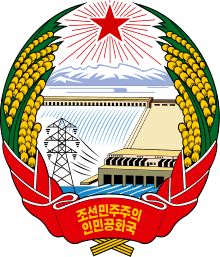North Korea–Philippines relations
 | |
North Korea |
Philippines |
|---|---|
The North Korea–Philippines relations (Korean: 필리핀-조선민주주의인민공화국 관계) relates to the diplomatic relationship of the Democratic People's Republic of Korea and the Republic of the Philippines.
Philippines has a non-resident ambassador in Beijing and North Korea has representation through its embassy in Bangkok.
History
Early years
During the Korean War, the Philippines allied with South Korea against North Korea.
Efforts to establish formal ties between the two countries began as early as the 1970s but such efforts saw no significant development by the 1980s. Factors hindering such efforts include the Philippines' traditional anti-communist foreign policy at that time as well as suspicions that North Korea is supporting the Communist Party of the Philippines and its armed wing, the New People's Army (NPA).[1] Limited North Korean support to the NPA was alleged by a 1990 report of the Patterns of Global Terrorism by the United States Department of State.[2]
Formal relations establishment
The Philippines in 1998 as chair of the Asean Regional Forum (ARF), initiated the process of admitting North Korea as a member in the forum but the latter said that Southeast Asian countries such as Brunei and the Philippines should establish formal relations with it first before it would join the ARF.[1]
The foreign ministers of the two countries met in New York in September 1999 in the sidelines of the UN General Assembly to discuss the improvement of bilateral ties which was followed by a meeting in Colombia during the Non-Aligned Movement Conference in April 2000 where they agreed in principle to establish diplomatic relations.[1]
The two countries formally established diplomatic relations on July 12, 2000[3][4] upon the signing of a joint communique by then Filiino Foreign Affairs Secretary Domingo L. Siazon, Jr. and North Korean Ambassador to Thailand, Jo In-chol in a ceremony conducted at the Department of Foreign Affairs office in Pasay, Metro Manila, Philippines.[1] This followed more than 20 years of negotiations.[5]The Philippines was among one of the last Asian countries to establish official diplomatic relations with North Korea.[4] North Korea within the same month joined the Asean Regional Forum.[1]
Further development
It was also reported in the early 2010s, that North Korea proposed to establish a resident embassy in Manila, which Philippine officials rejected. The rejection was reportedly due to Philippine authorities' suspicion on North Korean diplomats as they were deemed to have a reputation to conduct "extra-diplomatic activities" such as smuggling and counterfeiting in other foreign countries. Then-Philippine Foreign Secretary Siazon insisted that North Korea has never made such request. However, he remained open to expansion of diplomatic ties between the two countries.[5][6]
In 2007, the agreement was boosted further and was signed by Philippine Foreign Secretary Alberto Rómulo and North Korean Foreign Minister Pak Ui-chun during the Association of Southeast Asian Nations (ASEAN) meeting in Manila.
The Philippines, as an ally of South Korea and the United States, remains concerned and continues to condemn North Korea's nuclear and missile tests which is believed to be in violation of United Nations Security Council resolutions banning North Korea to use ballistic technology in any purpose.[7][8]
In March 2016, in compliance with United Nations (UN) sanctions, the Philippines impounded a North Korean ship, Jin Teng, but found no explosives or banned substances.[9] Weeks later another ship, Theresa Begonia, was impounded as well but no banned substances were found as either.[10]
Economic relations
According to the Philippine Department of Trade and Industry the primary exports of the Philippine to North Korea are bananas, computers, integrated circuit boards and women’s undergarments[11]
In 2017, the Philippines was reportedly the third largest trading partner of North Korea according to the Daily NK, next to India and China with the latter accounting to 90 percent of North Korea's trade.[12]
Trade relations were suspended by the Philippines in September 2017 to comply with United Nations Security Council Resolution which calls further sanctions against North Korea over its July 2017 missile tests.[11]
References
- 1 2 3 4 5 Parasa, Juanito (23 September 2017). "The Philippines vis-à-vis NKorea". The Manila Times. Retrieved 26 September 2017.
- ↑ "1990 Global Terrorism: State-Sponsored Terrorism". fas.org.
- ↑ "Joint Communique on the Establishment of Diplomatic Relations between the Republic of the Philippines and the Democratic People's Republic of Korea" (PDF) (in English and Korean). Archived from the original (PDF) on 4 September 2015. Retrieved 2 December 2014.
- 1 2 "DPRK Diplomatic Relations — National Committee on North Korea". Ncnk.org. Retrieved 1 September 2013.
- 1 2 "3RD LD: N. Korea, Philippines establish diplomatic ties. - Free Online Library". Thefreelibrary.com. Kyodo News International. 12 July 2000. Retrieved 10 June 2013.
- ↑ "Philippines, North Korea agree to boost bilateral relations". Monsters and Critics. Deutsche Presse-Agentur. 29 July 2007. Archived from the original on 14 October 2012. Retrieved 10 June 2013.
- ↑ Carcamo, Dennis (12 December 2012). "Philippines protests NKorea rocket launch". The Philippine Star. Retrieved 10 June 2013.
- ↑ "Philippines to press North Korea to stop missile test". Inquirer Global Nation. 26 March 2012. Retrieved 10 June 2013.
- ↑ http://edition.cnn.com/2016/03/05/asia/north-korea-nuclear-sanctions-philippines/
- ↑ http://www.upi.com/Top_News/World-News/2016/03/15/Philippines-seize-second-North-Korea-operated-ship/2611458059392/
- 1 2 Mogato, Manuel; Petty, Martin; Birsel, Robert (8 September 2017). "Philippines suspends trade with North Korea to comply with U.N. resolution". Reuters. Retrieved 26 September 2017.
- ↑ "Report: China accounts for more than 90% of North Korea's total trade". Dailynk.com. 11 April 2017. Retrieved 21 April 2017.

